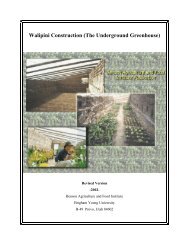GUINEA PIG MANAGEMENT MANUAL - Benson Institute
GUINEA PIG MANAGEMENT MANUAL - Benson Institute
GUINEA PIG MANAGEMENT MANUAL - Benson Institute
Create successful ePaper yourself
Turn your PDF publications into a flip-book with our unique Google optimized e-Paper software.
Vitamins activate bodily functions and help the animals to grow faster, improve their<br />
reproduction and protect them from various diseases. The most important vitamin in guinea pig<br />
food is Vitamin C. The lack thereof produces serious growth stunts, and in some cases can even<br />
cause death. Adequate fresh forage secures a sufficient quantity of Vitamin C.<br />
Water is the principal component of the body, indispensable for normal growth and<br />
development. Water sources for the animals are: water associated with food (fresh forage) that is<br />
not sufficient, and drinking water. For this reason, drinking water should be given to the guinea<br />
pigs, especially if there is little forage, and if it is ripe and/or dry.<br />
The reproducing guinea pigs need 100 cc of water per day to live. Lack of water<br />
in this stage can provoke cannibalism. Guinea pigs in the growing stage need 80<br />
cc of water per day, while breast-feeding guinea pigs need 30 cc per day.<br />
Water can be given out on plates made of clay, which should be washed and refilled with<br />
new water daily to avoid contamination.<br />
The following are guinea pig requirements according to the stage of production:<br />
<strong>GUINEA</strong> <strong>PIG</strong> NUTRITIONAL REQUIREMENTS<br />
Nutrients Unit<br />
Proteins<br />
Digestible Energy<br />
Fiber<br />
Calcium<br />
Phosphorus<br />
Magnesium<br />
Potassium<br />
Vitamin C<br />
%<br />
Kcal/Kg.<br />
%<br />
%<br />
%<br />
%<br />
%<br />
mg.<br />
Gestation<br />
Stage<br />
Breast-feeding Growing<br />
18.0<br />
18-22<br />
13-17<br />
2800.0<br />
3000.0<br />
2800.0<br />
8-17<br />
8-17<br />
10<br />
1.4<br />
1.4<br />
0.8-1.0<br />
0.8<br />
0.8<br />
0.4-0.7<br />
0.1-0.3<br />
0.1-0.3<br />
0.1-0.3<br />
0.5-1.4<br />
0.5-1.4<br />
0.5-1.4<br />
200.0<br />
200.0<br />
200.0<br />
Source: Nutritional requirements of Laboratory Animals, 1990, Universidad – NARIÑO, 1992.<br />
The most commonly used compositions of the food supplies are detailed in the following table:<br />
24



